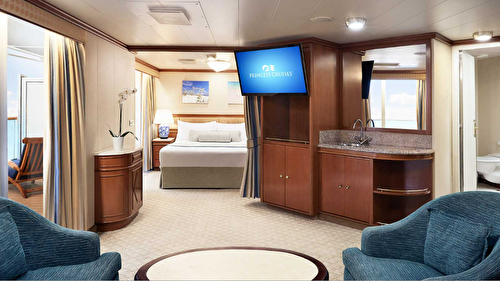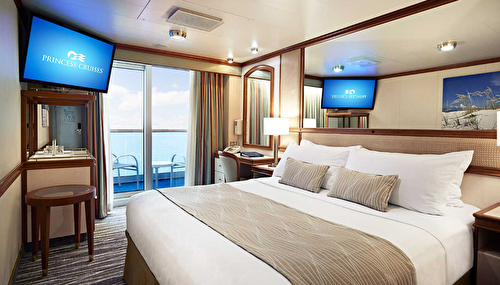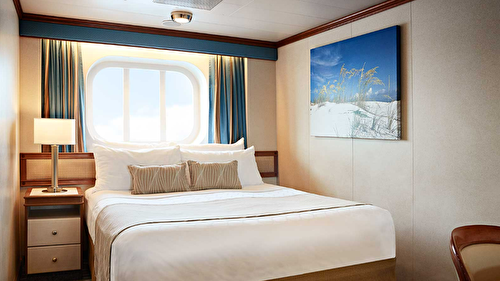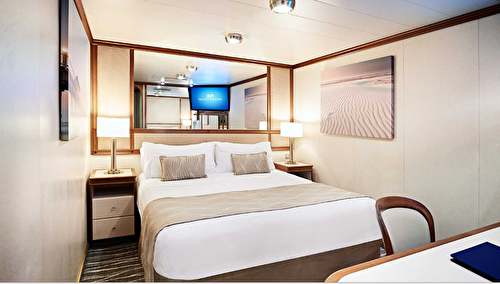Alaska & North Pacific Crossing
- 16 Apr ‘26
- 27 nights
- Departing from Tokyo (Yokohama)
- Coral Princess
-
Inside price from$7,201*/pp
-
Outside price from$7,660*/pp
-
Balcony price from$10,605*/pp
-
Suite price from$13,283*/pp
YOUR ITINERARY
Tokyo (Yokohama) - Miyako, Japan - Aomori - Hakodate - Cross International Dateline - Anchorage (Seward), Alaska - Hubbard Glacier (Scenic Cruising), Alaska - Glacier Bay (Scenic Cruising) - Skagway - Juneau - Sitka - Ketchikan - Victoria, British Columbia, Canada - Vancouver, Canada
Yokohama and Edo began life as sleepy fishing villages. That ...
Yokohama and Edo began life as sleepy fishing villages. That changed in the early 17th century after Tokugawa Ieyasu became Shogun. Edo became the center of political power in Japan, a position the city retained even after the restoration of Imperial rule in 1866.
Contemporary Tokyo may be the most astonishing city on earth. It’s a paradoxical mix of ancient tradition and postmodern culture. The Ginza – an international shopping mecca – stands near the serene grounds of the Imperial Palace, and the hyper-speed of 21st century consumerism is mysteriously reconciled with the elegance and serenity of traditional culture. Tokyo provides the traveler with a dizzying experience.
With the Meiji Restoration of 1868, Edo was renamed Tokyo, the “Eastern Capital,” to distinguish it from the old imperial capital at Kyoto, the “Western Capital.”
A pretty prefecture located on the northeastern coast of Hon...
A pretty prefecture located on the northeastern coast of Honshu, Japan’s main island, Miyako, Iwate, is situated along the Pacific coast surrounded by stunning scenery of Sanriku Fukko National Park and a sandy coastline defined by dramatic rock formations carved by the pounding surf. This iconic landscape invokes images of the ‘Pure Land,’ a Buddhist concept of paradise, and is best appreciated from the deck of a cruise boat on the waters of Jodogahama. The city’s natural wonders are woven within its cultural highlights, and a visit to Kamaishi Daikannon Statue, a towering statue of the Buddhist ‘Goddess of Mercy,’ showcases sparkling Kamaishi Bay, while the historic Rokando Cave, is home to “the waterfall of the heavenly cave,” an underground cascade. No visit to Miyako’s shores would be complete without paying reverence to the tragedy that occurred on March 11, 2011, when a powerful earthquake triggered a devastating 17-meterhigh tsunami. The Taro Kanko Hotel Tsunami Remains is a testament to the power of the community’s resiliency and serves as commemorative site, an important destination for those lucky enough to visit the island as it blooms with renewal.
The capital of the Aomori Prefecture in northern Japan, Aomo...
The capital of the Aomori Prefecture in northern Japan, Aomori derives much of its beauty from the apple orchards and cherry blossoms that encompass its landscape and the snow-covered Hakkoda Mountains that look on from a distance. Throughout its history, the city has been stricken with misfortune time and time again – in 1910, a fire destroyed Aomori, and during World War II, the city was left in ruins following an air raid – yet it always prevails.
Aomori is cherished by many who believe a local legend that the grave of Jesus Christ lies within the southern part of Aomori prefecture. However, Aomori is perhaps best known for its renowned Nebuta Festival, an elaborate yearly event in which participants illuminate giant paper representations of samurai warriors, animals, and popular cartoon characters while parading them through the streets.
It took Commodore Perry and American gunboat diplomacy...
It took Commodore Perry and American gunboat diplomacy to open Japan to the outside world after two centuries of self-imposed isolation. In 1859, the port of Hakodate became the first Japanese city fully opened to Westerners under the Treaty of Amity and Commerce. Foreigners soon flocked to Hakodate, and today visitors wandering the cobblestone streets of the city’s Motomachi District can view their Western-style frame houses. Hakodate, once a fishing port famed for its high quality fish and shellfish, quickly became Hokkaido’s largest city and one of Japan’s most important ports. The Great Hakodate Fire of 1934 dealt the city a near fatal blow – a blow from which Hakodate was slow to recover. Today the city is Hokkaido’s third largest – surpassed by Sapporo and Asahikawa – but retains its foremost position as the finest Japanese producer of sushi’s raw product: the high quality seafood caught in Hokkaido’s cold waters.
It may not compare to Tokyo’s Tsukiji’s Fish Market, but at Hakodate’s four-block-long Morning Market, vendors offer a stunning array of fresh fish and shellfish prized for sushi including salmon roe, sea urchin, scallops and crab. Restaurants and food stands prepare a wide arrange of dishes including domburi topped with fresh seafood.
The International Date Line is an imaginary line extending f...
The International Date Line is an imaginary line extending from the North Pole to the South Pole through the Pacific Ocean. It serves as the 180th meridian of longitude, and is used to designate the beginning of each calendar day. As you know, each adjacent time zone on the map has an hour time difference. However, at the International Date Line, +12 hours and -12 hours meet, bringing about a 24-hour time change. So while a person standing just to the west of the line may be celebrating Christmas Eve at 6 pm, someone just to the east will already be sitting down to Christmas dinner on December 25th. Therefore, when your ship crosses this line heading west, a day is added, and while crossing in an easterly direction, a day is subtracted. Crossing the International Date Line has long been a rite of passage for sailors, who often must participate in a line-crossing ceremony to become part of the sacred “Order of the Golden Dragon”, an honorary naval fraternity.
While sailing from Kodiak to Yakutat in 1791, Russian...
While sailing from Kodiak to Yakutat in 1791, Russian fur trader Alexander Baranov found shelter here from a storm. Because it was Easter, he named the haven Resurrection Bay.
Throughout the 1790s, Baranov used Resurrection Bay as Alaska’s first shipyard, building small, sturdy boats to hunt sea otters. In 1903, railroad surveyors formally established Seward as a sea terminal and supply center for the Alaska Railroad, mainly because of its deep, ice-free harbor.
The town also became a center for gold miners, trappers, loggers and fishermen. Between 1910 and 1911, miners blazed a 1,000-mile dog sled trail from Seward to Nome that became known as the Iditarod Trail. The community remained a quiet fishing port for the next several decades. All that ended in 1964 when an earthquake rocked the town. Miraculously, no one was killed, but it took several decades to completely rebuild the downtown area.
Nicknamed the “Galloping Glacier,” this east...
Nicknamed the “Galloping Glacier,” this east Alaskan glacier is rapidly advancing toward the Gulf of Alaska into a pristine area known as Disenchantment Bay. In fact, its movement temporarily formed a natural dam that twice closed off nearby Russell Fjord from the bay, but the intense water pressure building within the fjord-turned-lake has thus far been enough to explode through the wall of ice.
The largest tidewater glacier in North America, Hubbard Glacier measures 76 miles long and plunges 1,200 feet into the depths of the bay. Its immense beauty and phenomenal blue hues are enchanting, even from afar. But it’s when your cruise ship draws closer that its towering surface really impresses, dwarfing even the uppermost deck on your ship at a whopping 40 stories high. There, with the snowcapped mountains serving as a glorious backdrop, you’ll have a prime viewing spot from which to witness the glacier calving, as it often expels icebergs the size of 10-story buildings-imagine the splash!
The area around Hubbard Glacier is also renowned for its wildlife, where whales, harbor seals and otters swim, brown bears, moose and black-tailed deer roam ashore, and a wide variety of seabirds soar gracefully across the sky.
Skagway was the gateway to the gold fields for the th...
Skagway was the gateway to the gold fields for the thousands who flocked to Alaska and the Yukon with the hope of striking it rich. Skagway may have boasted the shortest route to the Klondike, but it wasn’t the easiest.
Over 100 years ago, the White Pass route through the Coast Mountains and the shorter but steeper Chilkoot Trail were used by countless stampeders. Many a would-be miner perished on the treacherous Chilkoot Trail.
The gold rush was a boon and by 1898, Skagway was Alaska’s largest town with a population of about 20,000. Hotels, saloons, dance halls and gambling houses prospered. But when the gold yield dwindled in 1900, so did the population as miners quickly shifted to new finds in Nome.
Today, Skagway has less than 1,000 residents. It still retains the flavor of the gold rush era.
In 1880, it was slow going for Joe Juneau and Ric...
In 1880, it was slow going for Joe Juneau and Richard Harris as they searched for gold with the help of Native guides. After climbing mountains, forging streams and facing countless difficulties, they found nuggets “as large as beans.”
From their discovery came three of the largest gold mines in the world. By the end of World War II, more than $150 million in gold had been mined. Eventually the mines closed, but the town Joe Juneau founded became the capital of Alaska and the business of gold was replaced by the business of government.
Some 30,000 people live in Juneau. Its total area makes it one of the biggest towns, in size, in the world. Only Kiruna, Sweden, and Sitka, Alaska, exceed Juneau’s 3,248 square miles.
Today Juneau is famous not only for gold and government but also for its breathtakingly beautiful glaciers and stunning views of both water and mountains.
In 1799, the Russian explorer Alexander Baranof founded ...
In 1799, the Russian explorer Alexander Baranof founded New Archangel next to the Tlingit village of Sitka.
This was the beginning of permanent Russian settlement in North America. But New Archangel was destroyed three years later by the Tlingit Indians in an attempt to reclaim their ancestral home. Their brief victory ended in 1804, when Baranof returned with warships and retook Sitka in the Battle of Alaska. Sitka was now the captial of Russian America.
In 1867, the Imperial Russian flag was replaced by the Stars and Stripes when the United States purchased Alaska. With the discovery of gold, and the rapid population growth that followed, Alaska’s capital was moved north to Juneau in 1906.
Today, picturesque Sitka, sitting opposite snow-capped Mount Edgecumbe, is known for its fishing, its annual summer classical-music festival and, of course, its many historic visitor attractions.
Ketchikan is known as Alaska’s “First City...
Ketchikan is known as Alaska’s “First City” because it’s the first major community travelers come to as they journey north. Located on an island, Ketchikan began life as an Indian fishing camp. The name Ketchikan comes from a Tlingit phrase that means “eagle with spread-out wings,” a reference to a waterfall near town.
In the early 1900s, when gold was Alaska’s claim to fame, fishing and timber industries were established in Ketchikan. The growth of these industries helped make this Inside Passage port Alaska’s fourth-largest city.
Visitors to Ketchikan will be intrigued by its rich Native heritage, which includes the world’s oldest collection of totem poles at Totem Heritage Center. The Haida, Tlingit and Tsimshian are all a part of the city’s colorful history. Ketchikan, with its abundance of salmon, is also a sportfishing paradise. Sightseers will be impressed with both the scenic town and its surroundings, especially Misty Fjords National Monument.
Victoria exudes old-world charm and fragrant, colorful f...
Victoria exudes old-world charm and fragrant, colorful flowers are everywhere. Founded in 1843 by James Douglas of the Hudson’s Bay Company, the city was first known as Fort Victoria. By 1848, Vancouver Island was a British colony and Victoria was its capital.
In 1858, Victoria was a tent city and the base for some 25,000 prospectors on their way to the Frasier River gold fields. When Vancouver Island was incorporated with mainland British Columbia in 1868, Victoria became the capital of the entire province.
Although it’s a port city, Victoria is not as industrially oriented as Vancouver. The harbors, especially Inner Harbour, are dotted with pleasure craft, ferries and floatplanes. The city is renowned for its beautiful gardens, charming houses and very British feel.
Vancouver, a bustling west coast seaport in British Colum...
Vancouver, a bustling west coast seaport in British Columbia, is among Canada’s densest, most ethnically diverse cities. A popular filming location, it’s surrounded by mountains, and also has thriving art, theatre and music scenes. Vancouver Art Gallery is known for its works by regional artists, while the Museum of Anthropology houses preeminent First Nations collections.
YOUR SHIP - The Coral Princess
Coral Princess, with more than 700 balcony staterooms, was custom built to navigate the historic Panama Canal. Be sure to try the Bayou Cafe and Steakhouse, which features New Orleans-inspired Cajun and Creole cuisine, join friends for cocktails and Movies Under the Stars by the pool or try some decadent treats at the International Cafe.
Coral Princess, with more than 700 balcony staterooms, was custom built to navigate the historic Panama Canal. Be sure to try the Bayou Cafe and Steakhouse, which features New Orleans-inspired Cajun and Creole cuisine, join friends for cocktails and Movies Under the Stars by the pool or try some decadent treats at the International Cafe.
Churchill Lounge
Lido Pool
Lotus Spa
Splash Pool
Whirlpool
Card Room
Golf Simulator
Library
Mini-golf course
Outdoor Pool
Shuffle Board
Swim-against-the-current lap pool
Children’s Play Area
Explorers Lounge
Movies Under the Stars outdoor theater
Photo Gallery
Princess Theatre
Show Lounges
Theatre
Art Gallery
Atrium
Boutique
Duty-free shop
Future Cruise Sales
Medical Centre
Photo Shop
ScholarShip@Sea
Shore Excursion Office
Wedding Chapel
Writing Room
24-hour Buffet Bistro
24-hour Room Service
Bayou Café & Steakhouse
Bordeaux Dining Room
Churchill Lounge
Crooners Bar
Dining Room
Explorers’ Lounge
Grill
Horizon Court
Ice Cream Bar
Lobby bar & patisserie
Martini Bar
New Orleans Style Restaurant
Patisserie
Poolside Grill
Poolside Pizzeria
Princess Pizza
Provence Dining Room
Sabatini’s Italian Trattoria
Sabatini’s Italian restaurant
The Bayou Cafe
The Grill (burgers & hot dogs)
Wheelhouse Bar
Ocean View Gymnasium
Tennis
Description
Coral Princess, with more than 700 balcony staterooms, was custom built to navigate the historic Panama Canal. Be sure to try the Bayou Cafe and Steakhouse, which features New Orleans-inspired Cajun and Creole cuisine, join friends for cocktails and Movies Under the Stars by the pool or try some decadent treats at the International Cafe.
Relaxation
Churchill Lounge
Lido Pool
Lotus Spa
Splash Pool
Whirlpool
Recreational
Card Room
Golf Simulator
Library
Mini-golf course
Outdoor Pool
Shuffle Board
Swim-against-the-current lap pool
Entertainment
Children’s Play Area
Explorers Lounge
Movies Under the Stars outdoor theater
Photo Gallery
Princess Theatre
Show Lounges
Theatre
Other
Art Gallery
Atrium
Boutique
Duty-free shop
Future Cruise Sales
Medical Centre
Photo Shop
ScholarShip@Sea
Shore Excursion Office
Wedding Chapel
Writing Room
Food and Drink
24-hour Buffet Bistro
24-hour Room Service
Bayou Café & Steakhouse
Bordeaux Dining Room
Churchill Lounge
Crooners Bar
Dining Room
Explorers’ Lounge
Grill
Horizon Court
Ice Cream Bar
Lobby bar & patisserie
Martini Bar
New Orleans Style Restaurant
Patisserie
Poolside Grill
Poolside Pizzeria
Princess Pizza
Provence Dining Room
Sabatini’s Italian Trattoria
Sabatini’s Italian restaurant
The Bayou Cafe
The Grill (burgers & hot dogs)
Wheelhouse Bar
Fitness
Ocean View Gymnasium
Tennis
STATEROOMS

suite

balcony

outside


